Black and Yellow Bees, Wasps and Hornets (With Pictures) – Identification Guide
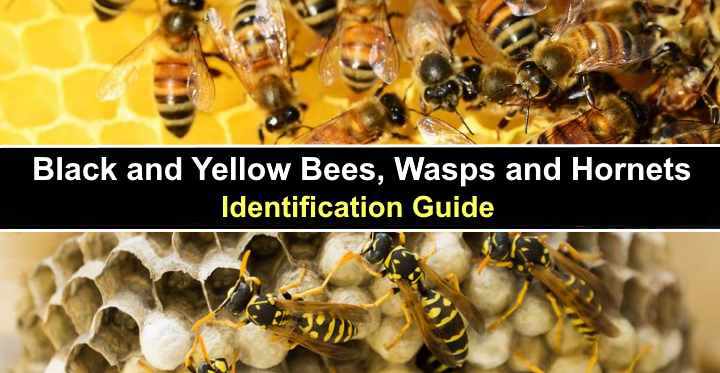
Black and yellow bees, wasps, and hornets are small flying insects that are easy to confuse. Identifying black and yellow wasps is tricky because some wasps look like bees. Additionally, hornets with black and yellow stripes are a type of wasp but have more aggressive behavior. There are also species of bees that seem aggressive; however, the black and yellow insects exhibit defensive behavior only when threatened.
Many insects look like yellow and black bees due to their behavior, size, appearance, and flying action. Typically, it’s easy to mistake wasps or hornets for bees. Therefore, knowing the identifying features of these three species of flying insects will help to recognize each type.
This article is an identification guide to the most common types of black and yellow bees, wasps, and hornets. Descriptions and pictures of their yellow and black stripes, behavior, and size will help you tell the difference between the species.
Bees Vs. Wasps Vs. Hornets
Have you noticed an insect with black and yellow stripes flying around your yard? The chances are that it is either a bee, wasp, or hornet. But how can you tell the difference?
Generally, bees have hairier, stouter bodies than wasps or hornets. In contrast, hornets and wasps with yellow and black markings tend to have thin waists and slender bodies. Another difference is that wasps and hornets can sting multiple times, making them more dangerous. On the other hand, stinging bees can only sting once.
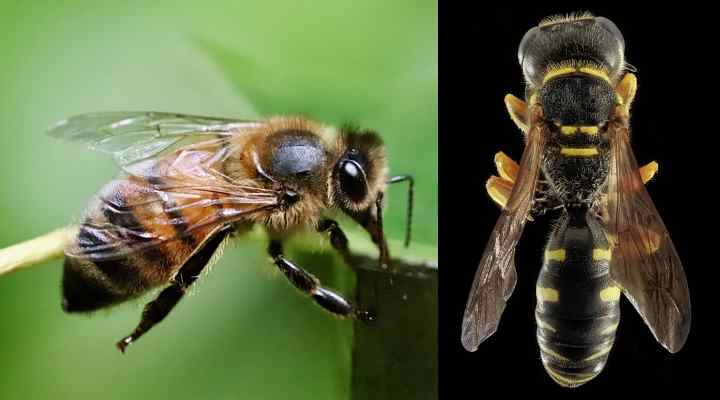
Close up pictures of a honey bee (left) and a wasp (right)
The species of bees and wasps most challenging to differentiate are yellowjackets and honey bees. Both these black and yellow winged insects have relatively slender bodies. However, you’ll notice that yellowjacket wasps have thinner waists than honey bees.
The size of the wasp or bee’s body is another way to identify the type of black and yellow winged insect. Hornets are larger than bees or wasps, measuring up to 1.5” (38 mm) long, whereas wasps and bees are between 0.25” and 1” (6 – 25 mm) long.
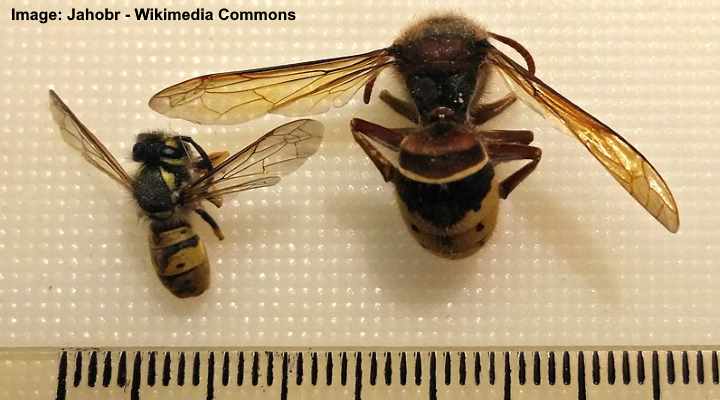
Size comparison of wasp (left) and hornet (right)
Black and Yellow Bees (With Pictures) – Identification Guide
The most common species of bees with black and yellow markings are bumble bees, honey bees, and plasterer bees. Africanized honey bees—sometimes called killer bees—have a more defensive behavior than typical honey bees. The following guide explains identifying features of common black and yellow bees.
Bumble Bee (Bombus)
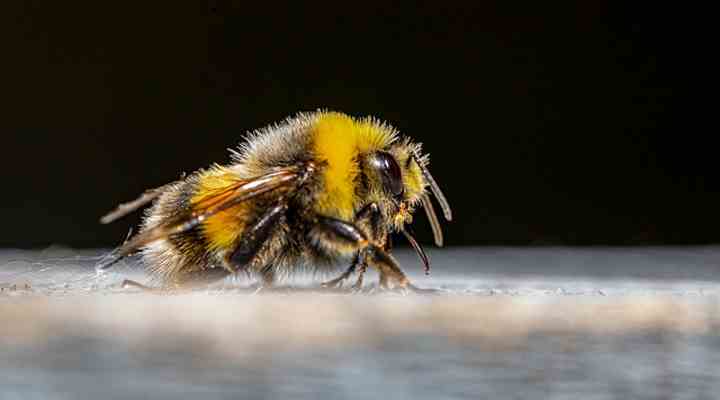
Bumble bees can be identified by their fuzzy appearance and stout black and yellow body with a white tail
The bumble bee (bumblebee) is a brightly colored bee with black and yellow markings and a furry body. Bumble bees generally have a stout, almost barrel-shaped body covered in soft, fine hairs. Like wasps and hornets, bumble bees have six legs, two antennae, and a pair of translucent wings.
Bumble bees are easy to identify because they have a stouter body than honey bees and a rounded abdomen. Depending on the species, bumble bees measure between 0.4” and 0.9” (11 to 22 mm) long. There is also variation in bumble bee species; not all are black and yellow furry flying insects.
A distinctive habit of bumble bees is their fuzzy black and dull yellow to dark orange bodies covered in pollen and pollen baskets on their hind legs.
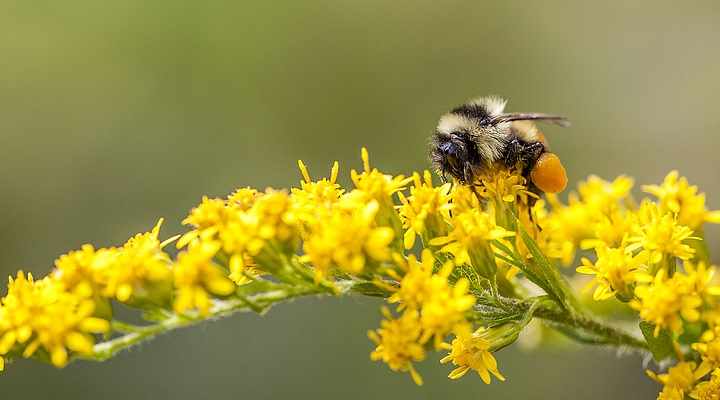
Bumble bee with a pollen basket
Honey Bees (Apis)
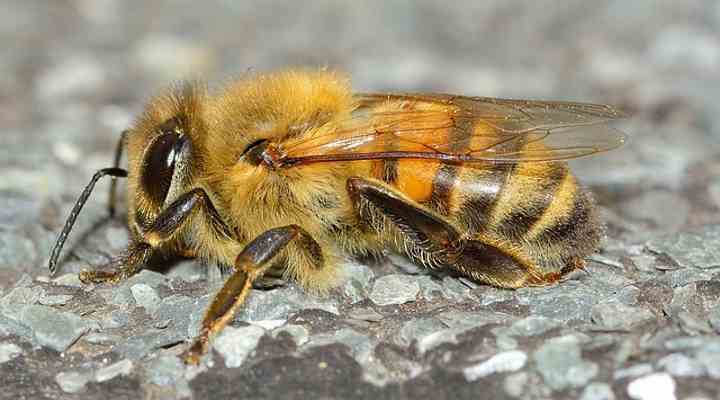
The Western honey bee (Apis mellifera) has black and orange-yellow bands on the abdomen and hair on the thorax
The honey bee (honeybee) is a species of bee with black and yellowish-orange stripes. Identifying features of honey bees are the dull yellow furry thorax, slightly fuzzy striped abdomen, and large brown compound eyes. Additionally, they have six spiny brown legs and two crooked antennae.
The western honey bee is the most common type (Apis mellifera). The slender bee has a banded abdomen with black and orange-yellow stripes. The small bees measure up to 0.5” (12 mm) long and have a recognizable orange pollen pouch (called a corbicula) on their back legs.
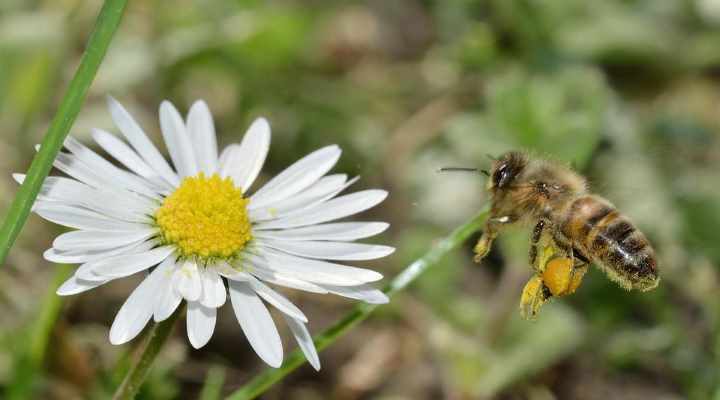
Apis mellifera with pollen pouches
Although bees are famous for producing honey, there are only eight honey-making bee species. These include the eastern honey bee (Apis cerana), Koschevnikov’s honey bee (Apis koschevnikovi), and Philippine honey bee (Apis nigrocincta). However, unlike the western honey bee, these species aren’t black and yellow bees.
Africanized Honey Bees (Apis mellifera scutellata)
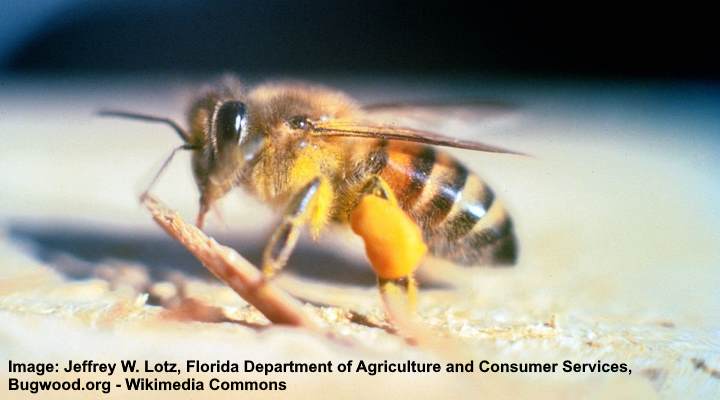
The black and yellow Africanized honey bee has an aggressive behavior and is slightly smaller than the Western honey bee
The Africanized honey bee is a hybrid bee with a shiny black abdomen and vibrantly colored yellow bands traversing it. Identifying characteristics of this yellow and black bee include aggressive defensive behavior, flying in large swarms, and they tend to live in the ground. The non-native honey bees measure 0.74” (19 mm) long.
Africanized honey bees are an invasive species in the southern states of North America. The pesky black-yellow honey bees are common in Texas, Louisiana, Arizona, Nevada, and southern California.
Compared to Western honey bees, Africanized honey bees look similar but are slightly darker and smaller. The name “killer bees” refers to their aggressive behavior where they will attack when provoked and pursue humans for up to 440 yards (400 m). The small yellow and black bees will also kill Western honey bees and take over their hives.
Plasterer Bees (Colletes)
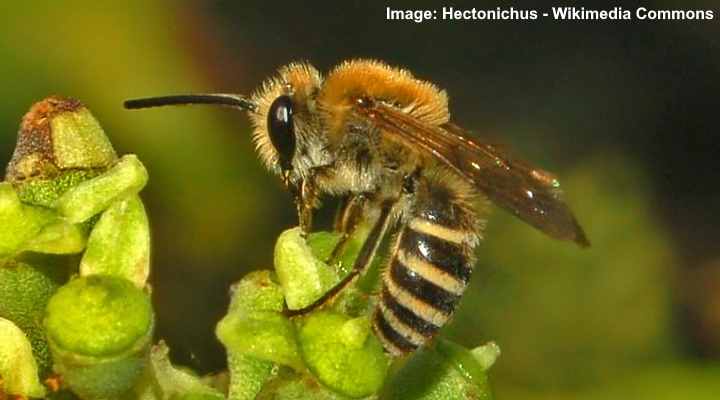
The ivy bee (Colletes hederae) is a type of black and yellow plasterer bee
Plasterer bees are a group of black bees with yellow or orange-striped abdomens that nest in the ground. The black and yellow species of plaster bee is the ivy bee (Colletes hederae). This flying insect measures 0.5” (12 mm) long and has a smooth black abdomen with bands of yellowish-orange hairs.
The ivy bee is often found feeding on flowers on the common ivy plant (Hedera helix). However, if there are not enough ivy plants, the black and yellow striped bees will feed on nectar from flowers in the daisy family. The slender bees are generally solitary and build nests in the ground.
European Wool Carder Bee (Anthidium manicatum)

The European wool carder bee is identified by its black broad body with yellow dots
The European wool carder bee is an unusual black bee with yellow dotted markings around its abdomen. Each black segment of the bee’s abdomen has a bright yellow spot or triangular mark. Additionally, the black and yellow bee has yellow legs, black translucent wings, and two black antennae.
The European wool carder bee is related to mason bees. Unfortunately, in North America, this European bee species has become an invasive pest.
An identifying feature of the shiny black and yellow bee is its relatively thin waist. However, this species has a broad body compared to wasps that typically also have thin waists. Also, the bees have yellowish spots on their black faces. Male wool carder bees measure 0.55” to 0.67” (14 – 17 mm) long.
Black and Yellow Wasps (With Pictures) – Identification Guide
Wasps with black and yellow stripes and markings are extremely common. The most easily recognizable yellow and black wasp is the yellowjacket. However, paper wasps, potter wasps, and mud daubers are also common black and yellow striped wasp species in North America. The following guide explains identifying features of common black and yellow wasps.
Yellowjackets (Vespula or Dolichovespula)
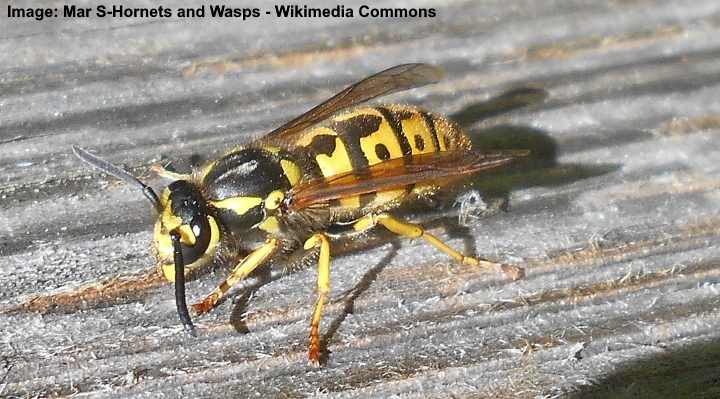
A close up picture of Vespula germanica (European wasp, German wasp, or German yellowjacket) that is well established in the Northern Hemisphere
Yellowjackets or yellow jackets are the most common type of yellow and black wasp. The wasp’s identifiable features are its yellow abdomen with black bands and dots, black thorax with yellow markings, and a yellow and black face. The yellow-black wasps average around 0.47” (12 mm) long.
The common yellowjacket wasps are easy to confuse with honey bees, hornets, or European paper wasps. Unlike bees, yellowjackets lack the yellowish-brown fuzzy appearance and don’t have characteristic hind legs with pollen pockets.
These black and yellow wasps build nests in trees, shrubs, or under roofs.
There are several species of yellowjackets native to North America. These species include the eastern yellowjacket (Vespula maculifrons), western yellowjacket (Vespula pensylvanica), prairie yellowjacket (Vespula atropilosa), and the North American yellowjacket (Vespula alascensis).
European paper wasp (Polistes dominula)

The black and yellow European paper wasp is longer with thinner waist compared to yellowjackets
The European paper wasp is a common black wasp with brightly colored yellow bands traversing its pointed abdomen. The wasp’s characteristics are its pale orange legs, black face and thorax with yellow dots, and translucent brownish wings. The black and yellow European paper wasp measures 0.37” to 0.51” (9.5 – 13 mm) long.
Paper wasps are easy to confuse with yellowjackets. The differences between the two species of wasps are that paper wasps have a longer body and thinner waist. Unlike hornets and yellowjackets, paper wasps generally stay away from humans and only attack when they feel threatened.
Paper wasps are considered beneficial insects because they help eliminate common garden pests. The black and yellow wasps feed on flies, caterpillars, beetle larvae, and nectar.
Cicada Killer Wasps (Sphecius)
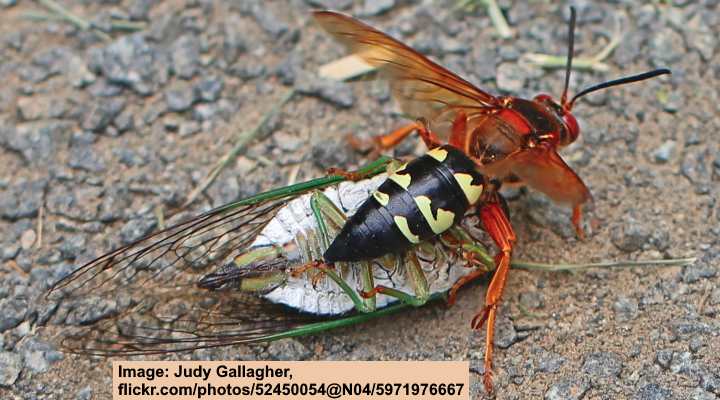
A picture of Eastern cicada killer (Sphecius speciosus) with a cicada
Cicada killer wasps are large, black, yellow, and red wasps with unique coloration, making them easy to identify. The killer wasps have a black abdomen with yellow stripes across the abdomen and yellowish stripes on their thorax. In addition, this unusual wasp has orange-red legs and a red head with two black antennae.
Giant black, yellow, and red cicada killer wasps measure 1.5” to 1.75” (38 – 44 mm) long. The eastern cicada killer (Sphecius speciosus) and the western cicada killer (Sphecius grandis) both have identifiable bright yellow abdominal markings. However, the eastern cicada killer is the black and yellow species.
Although the colorful cicada killer wasps look and act aggressively, they are relatively harmless wasps. Males don’t possess a stinger, and the black, red, and yellow-colored females only have a weak sting.
Potter Wasps (Eumenidae)
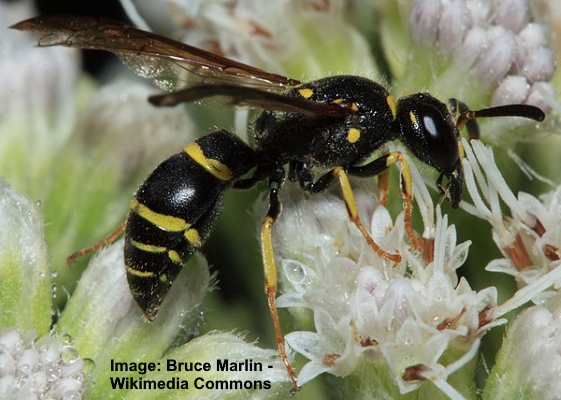
Potter wasps have a black slender body with thin yellow bands and are also called mason wasps
Potter wasps are slender black flying insects with contrasting thin yellow bands around their abdomens. Other identifying features of potter wasps are the black and yellow legs, black thorax with yellow spots, and shiny black head. Additionally, the wasps have thick, black antennae. Depending on the species, potter wasps are 0.39” to 0.78” (10 – 20 mm) long.
Also called mason wasps, potter wasps get their name from their distinctive nest-building habits. Species of potter wasps make nests from mud, creating vase-like structures where they raise their young.
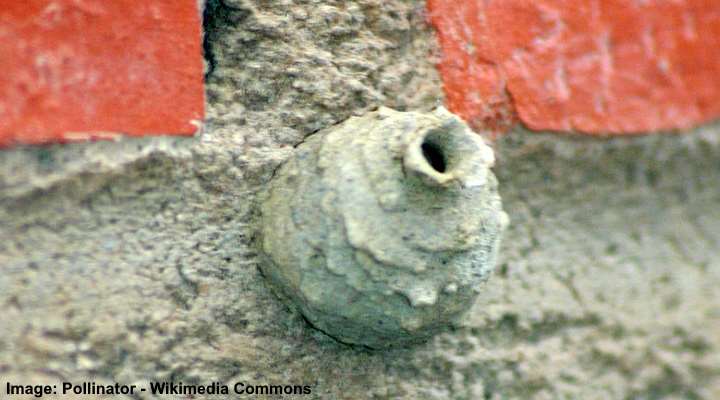
Potter wasp nest
Black and Yellow Mud Dauber (Sceliphron caementarium)

The black-and-yellow mud dauber wasp can be identified by its very slim waist
The black-and-yellow mud dauber is a distinctive black wasp with an exceeding thin waist (called a petiole) between its thorax and abdomen. The solitary wasps have a black thorax with yellow markings, a black abdomen, yellow legs, and long, curved black antennae. Black-and-yellow mud daubers measure 0.9” to 1.1” (24 – 28 mm).
Other names for the black and yellow mud dauber wasp include the yellow-legged mud-dauber or black-waisted mud dauber. The slender wasps build nests consisting of cylindrical cells covered in mud.
Black-and-yellow mud dauber wasps are common throughout the United States, Canada, and Europe. The non-aggressive wasps feed on nectar, small insects, and spiders. You will generally find adults on wild carrot and parsnip flowers.
Saxon wasp (Dolichovespula saxonica)
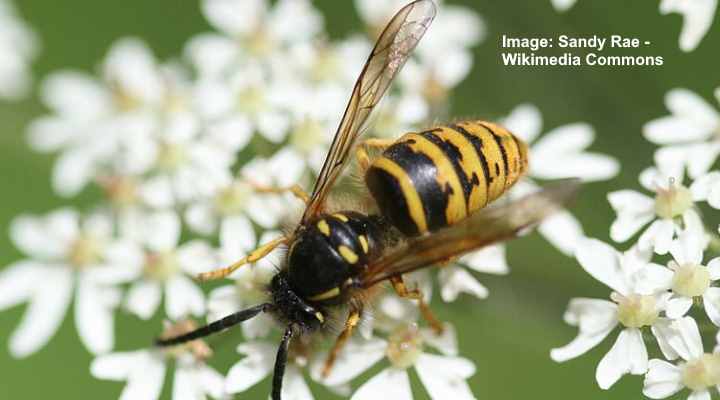
The Saxon wasp is very similar to yellowjackets
The Saxon wasp is a black and yellow wasp that looks like a yellowjacket. The wasp has a characteristic black and yellow striped abdomen, black thorax with three small yellow dots, and bright yellow markings on its face. Worker Saxon wasps measure 0.43” to 0.59” (11 – 15 mm) long.
Saxon wasps build their nests in trees using the fibers from rotten wood. The wasp nests can be identified by their rounded shape, smooth gray exterior, and a single hole at the base of the nest. The yellow-striped, black wasps will also build nests under porches, roofs, and on the sides of buildings.
Tree wasp (Dolichovespula sylvestris)

The tree wasp has a black and yellow bands on its abdomen and builds nests on trees and on the ground
The tree wasp is a medium-sized wasp, identified by its black and yellow stripes, yellow legs, and black thorax with two yellow dots. The native European tree wasp measures 0.43” to 0.59” (11 – 15 mm) long and has large, hooked antennae and brownish wings. It is related to yellowjackets, hornets, and other social wasps.
Despite their name, tree wasps, the black and yellow wasps will build nests hanging from trees and hedges as well as in the ground. Although the wasp is not aggressive, it will attack if the nest is threatened.
Tree wasps generally feed on small insects and will also consume nectar from plant flowers on rhododendron, blackberry, and raspberry plants.
Black and Yellow Hornets (With Pictures) – Identification Guide
Black and yellow hornets are a type of giant wasp with striped bodies. Hornets with yellow and black markings are easy to spot because of their large size, loud buzzing noise, and aggressive behavior. The following guide explains identifying features of common black and yellow hornets.
European Hornet (Vespa crabro)

The large European hornet has black and red thorax and its abdomen is black and yellow
The European hornet is the largest type of wasp with a mainly yellow body and black markings. The hornet’s identifying features are its dull yellow abdomen with thick black bands near the thorax, which is black and red. Additionally, the hornet has reddish-brown legs, a brown face, and large brown compound eyes.
The European hornet measures around 1” (25 mm) long, and queen hornets are significantly larger—up to 1.4” (35 mm). Therefore, the easiest way to differentiate between yellowjackets and European hornets is their size. Although people associate European hornets with aggressiveness, they usually only attack when threatened.
Black Shield Wasp (Vespa bicolor)
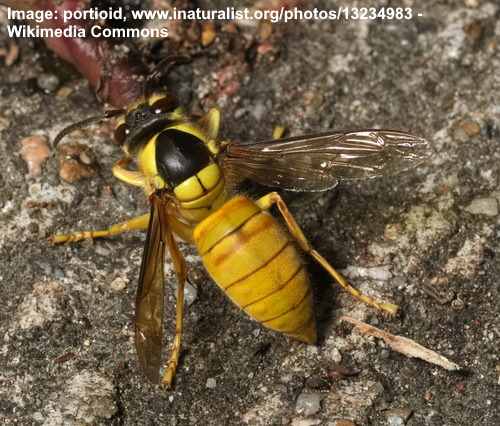
The black shield wasp has mainly yellow abdomen and black triangular on the thorax and is relatively small
The black shield wasp is a type of yellow hornet with a black triangular mark on its thorax and thin brown lines traversing its abdomen. This hornet is easy to differentiate from the other hornet species because it is mainly a dull, orange-yellow to bright yellow color. In addition, its legs and facial markings are also yellow.
The name of the black shield wasp comes from the distinctive black mark on its yellow thorax. This fast-flying hornet is the smallest of the hornets, measuring 0.59” to 0.74” (15 – 19 mm) long. Black shield wasps build large, ball-like nests high up in trees or hanging from roofs or other structures.
Like all types of hornets, the black shield wasp can become aggressive if you disturb the nest. Despite the hornet’s small size, it delivers an excruciatingly painful sting.
Yellow Hornet (Vespa simillima)

The yellow hornet has black and yellow striped abdomen with black thorax and red dots
The yellow hornet—also called the Japanese yellow hornet—is a large type of wasp with contrasting yellow and dark brown-black stripes. Other identifying features of the yellow hornet are its back thorax with a few red dots, brownish legs, and two brown antennae. These hornets measure 0.8” (20 mm) long, and the queens are 1” (25 mm) long.
A characteristic of yellow hornets is their large swarms of between 1,000 and 2,000 yellow wasps. The hornets can be dangerous because they attack in large groups and will chase people for hundreds of yards.
Related articles:
